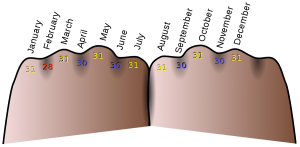Date Range Calculations
Do you remember learning how many days each month had in school? You probably learned this rhyme or something like it…
Months of the year30 days has September,
|
Forget the rhyme, however, and all is lost. An alternative way is to use your hands. When we make a fist, we form a line of four projecting knuckles with three dips between them on each hand. This pattern helps us remember the pattern of the number of days in the months.
Your first knuckle of your little finger represents January. All the protruding months – January, March, May, July, August, October and December have 31 days. The others are all short months which usually means 30 days but February is 28 or 29 depending on whether it is a leap year. Easy?
Leap years
The rule for leap years is that if the year divides by four to give a whole number, like 2000 and 2004 for instance, then it is a leap year. (It gets a bit more complicated for other centuries like 1800 and 1900 but you shouldn’t worry about that.)
Calculating Date Ranges
Our advice here is to use tables to count up the range. Start with the next day as 1 after and then each month’s total to the running total. These are tricky and it’s easy to make a mistake. Have a look at the answer sheet below for an example and be careful!
![]()
Worksheet
Answers
Found this useful? Then why not tell your Facebook Friends?

